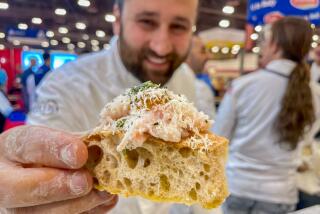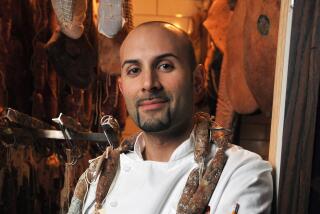California Pizza Kitchen tries a new look: Rustic, rough, organic
To know one California Pizza Kitchen restaurant is to know them all — the black-and-tan booths, low-pile carpeting and acrylic panels.
Now, the 28-year-old mall staple known for a pervasive sense of sameness is undergoing what its CEO calls a “de-chaining,” upgrading its image and menu to be more individual, relevant and attractive to foodies.
The brand, known as CPK, is opening a prototype eatery Wednesday in the Westfield Topanga mall in Canoga Park, its first new location near its Los Angeles home base in five years.
To describe the decor, executives are using terms such as “rustic,” “rough,” “organic” and “relaxed.” The woodwork, including old railroad trestles from Utah and tabletops made from barn doors, is all reclaimed from past projects. The host stand features chalkboard signs and a wall of herbs such as basil, sage and fennel.
“We may have lost some of our original creativity,” Chief Executive G.J. Hart said. “We wanted to evolve.”
It’s a tactic being embraced by many major multi-unit eateries trying to start fresh after the recession, which pummeled the restaurant industry, especially the casual sit-down segment. Their customers turned to home-cooked meals and fast-food restaurants.
Fine-dining establishments also squeezed mid-tier restaurants such as CPK by relaxing their dress codes and launching gourmet happy hours with small plates.
In 2009, chain restaurant revenue tumbled 3.7% before picking up to 2.9% growth annually through 2012 and an expected 5.5% boost this year, according to research group IBISWorld.
During the recovery, a growing culinary curiosity propelled by cooking shows and celebrity chefs caused Americans to increasingly think of chains as dowdy and corporate. Diners began looking for more healthful, creative and locally sourced meals at farmers markets, food trucks and neighborhood eateries beloved by bloggers.
“The casual-dining industry struggled through the recession,” Hart said. “CPK got hurt like everyone else.”
To entice customers back, many restaurant companies began taking cues from more high-end competitors.
Domino’s this year unveiled a “pizza theater” concept, allowing customers to watch chefs work in an open kitchen and leave comments on chalkboards. P.F. Chang’s Innovation Bistro concept in Irvine leans heavily on wood detailing and open-air spaces.
“Full-service casual-dining restaurants … are implementing upscale decor, offering new flavors or ethnic foods, expanding their lineup of specialty beverages and creating concept spinoffs that blur the lines between restaurant segments,” Technomic researchers wrote in a report last year.
CPK, owned since 2011 by private equity firm Golden Gate Capital, invested nearly $2 million in its Topanga mall prototype store.
The restaurant takes up prime real estate near swanky retailers such as Henri Bendel and Burberry, sitting squarely in the center of the massive shopping center instead of being shunted off to the food court or hidden near an exit.
A 1,000-square-foot open-air bar space operates directly in the traffic flow of the mall’s indoor avenue. Wine bottles — mostly from local boutique wineries — rest on a rusty iron cube. A few steps away, an enclosed, 5,351-square-foot eatery reminiscent of a Hamptons porch or a European cafe makes up the second portion of the concept.
The chain’s love affair with chrome has faded in favor of white shutters and fresh produce prominently displayed in the open kitchen. Large communal tables and a unisex hand-washing station outside the restrooms are meant to evoke a warm family home.
“We’re trying to get away from that very expected, shiny chain feel,” said Clint Coleman, CPK’s chief development officer.
Tables and chairs can be readjusted into different configurations, a departure from the mostly bolted-down furniture in older restaurants. Eateries such as the Water Grill and Mimi’s are taking similar steps to create the feel of multiple restaurants in one, a move that attracts a wider diner demographic by offering a more varied dining experience.
Coleman said the flexibility helps create “vignettes” around the Topanga space, with rowdy parties in the back section, families near the wide windows and a congregation of foodies around the pizza oven as if at an intimate sushi bar.
CPK’s servers no longer wear matching gear and recite a preset script with guests. Instead, employees are encouraged to dish up their natural personalities and be more individualistic with their apparel. Hart calls it “high-five hospitality.”
There’s also a more high-end sheen to the chain. For the first time, CPK is offering table-side pours of white truffle oil with certain dishes. The plates, glasses and flatware are sleeker. The “tree free” napkins are made with sugar cane.
The pizzas are designed to be more artisanal. The dough, which has been machine-pressed since 1992, has been reformulated to be fluffier and hand-molded.
Desserts include a pudding made with trendy salted caramel, served in a canning jar. A leaner menu, with 22 fewer items than a year ago, includes a new flatbread category and items under 600 calories. A line of gluten-free pizzas will arrive by the end of the year.
It’s a change from the CPK that earned a D+ grade from the Men’s Health “Eat This, Not That” nutritional tracker. The fitness magazine called out “many offenses,” including “one of the most caloric salad menus in America, a disastrously fat-burdened Specialties lineup and a few of the worst pasta dishes we’ve seen anywhere.”
Now, Coleman said, “the sophistication of people’s culinary expectations has grown.”
Some 30% of casual-dining customers say they order from health-centric menus more often than a year ago, according to Technomic.
“The guest has certainly evolved as a species,” Coleman said.
Hart said he has a “very aggressive remodel schedule” planned for the chain’s hundreds of locations. To emphasize the uniqueness of each individual branch, art on the walls of future eateries will feature black-and-white images from California interspersed with color photos representing the local culture.
And some new locations may break the shopping tether, he said.
“Historically, we’ve gone into malls,” he said. “But we’re moving more so into lifestyle centers of late. We’re looking for alternative locations.”
Twitter: @tiffhsulatimes







